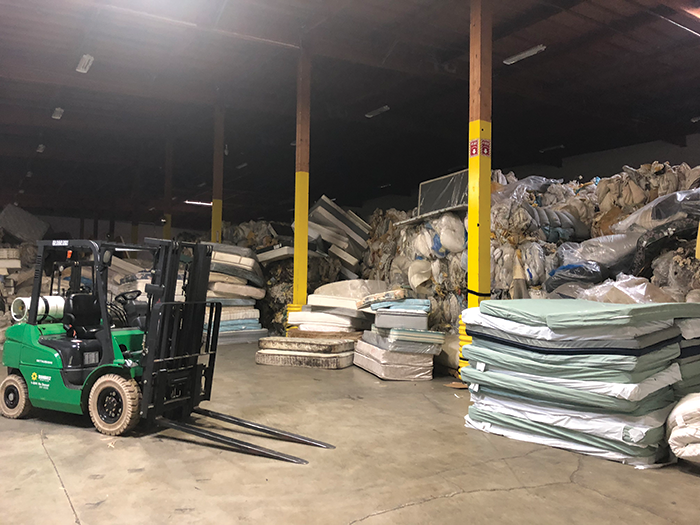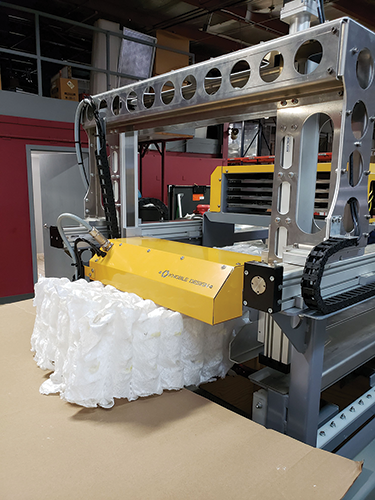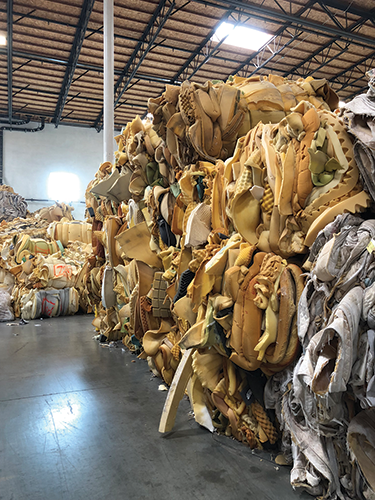In Mattress Recycling Council’s ongoing efforts to advance mattress recycling and to provide enhanced earnings potential to recycling partners, the organization continues to seek novel ideas to diversify and grow end markets.
By Mike O’Donnell
There is no rest for the mattress industry when it comes to recycling. Through the work of the Mattress Recycling Council (MRC), which was created to administer statewide programs in California, Connecticut, and Rhode Island, more than 10 million mattresses have been recycled since 2015.
To make mattress recycling sustainable and profitable for recyclers, MRC is investing nearly $1 million annually in research targeting mattress collection, transportation, and recycling activities. Since 2017, MRC has funded 20 projects to improve process efficiencies, recover more recyclable material, improve end markets, and understand the composition of discarded mattresses and box springs.
Research efforts identify and fund projects that have the potential to achieve both short-term, high-impact results, as well as longer-term projects with multi-year horizons. Let’s talk about some of these projects.

Steel
Traditionally, mattresses were constructed with continuous coil hourglass shaped spring structures, referred to as Bonnell coils. These springs are made from a high carbon steel and are readily recycled in scrap ferrous markets if the springs are compressed or shredded. Newer mattresses may contain pocketed coils which are wrapped in a fabric sleeve or pocket, typically polypropylene fiber, and then assembled into rectangular units using ultrasonic welding, stitching or adhesives. MRC estimates that 27 percent of discarded units contain pocketed coils, and that this percentage will gradually increase given the growing popularity of this component over the past 20 years.
To recycle pocketed coils, the fabric surrounding the coils must be removed to yield clean scrap steel. However, manually removing the fabric is a difficult, time-consuming task. MRC sought a long-term solution to the problem in the form of one or more practical pocketed coil separation technologies. We began the process by discussing technical challenges with manufacturers of pocketed coils and recycling equipment. Based on this input, MRC awarded a contract to develop a low-cost, automated machine to
efficiently separate the metal coils from the pockets without destroying either material. A patent has been filed on the design and AAC Equipment Co. is working to scale the prototype to full scale production.
Foam
Today, almost all post-consumer mattress foam is remanufactured into carpet padding, however, the tastes of American homeowners are shifting away from carpet to durable hard flooring surfaces. MRC anticipates a day when demand for mattress foam by carpet padding manufacturers will decrease significantly. To find new and higher yielding markets, MRC is seeking new uses for this polyurethane foam through two important studies.
In 2021, UCLA released an MRC-funded research report evaluating the performance of chemically recycled polyurethane foam in cast concrete products. In the study, the liquified foam was used as a binding ingredient and mixed with zeolites, an abundant, naturally occurring porous mineral. In lab tests, the recycled polyurethane outperformed virgin polyurethane agents in making the same cast concrete products. Among the potential products are concrete highway barriers, which have the potential to use 600,000 pounds of recycled foam per mile.
Another benefit is that cement made with upcycled polyurethane combined with the zeolites requires less energy to produce than common portland cement. UCLA researchers have filed a patent application for this process.
In a second project, MRC is seeking research proposals that use post-consumer mattress foam in oil absorption applications like cleaning up oil spills. The Argonne National Laboratory demonstrated in 2017 that chemically treated polyurethane foam can absorb oil floating on and below water surfaces and that the sponge can be wrung out and reused. This is the only technology that effectively adsorbs oil below the water surface and has significant potential in oil spill applications. However, the use of new polyurethane foam for this purpose is limited due to costs. MRC seeks to fund a proof-of-concept test to see if post-consumer mattress foam can be an economically viable substitute.

Waste Characterization
One of MRC’s first studies characterized the age and weight of discarded units. This study was important for forecasting purposes and determining the total weight of material collected by our programs. What we learned was that units of all types and sizes are on average, 11.2 years old and they weigh 55 pounds. MRC will replicate these studies in future years to monitor changes in waste stream composition.
To achieve a higher program-wide recycling rate, it is important to understand how much and which materials are going to landfill and why. So, our next characterization study analyzed the 25 percent of material that recyclers landfilled due to the lack of end markets, contamination, or difficulty preparing the material for buyers. We discovered that the top three most prevalent waste categories as a percentage of total waste are shoddy felt pad (22 percent), mixed non-woven fibers (19 percent), and quilt panels (17 percent). This non-recyclable fraction is a continued focus for our research team.
Textiles
A variety of fibers and fabrics are used in mattress construction. Although recyclers can effectively separate this material, there are limited end markets, especially when natural and synthetic fibers are blended together in textile applications. MRC is funding several studies to explore solutions to textile waste.
Rensselaer Polytechnic Institute in New York is currently investigating a method to dissolve and then salvage some of these fibers using commercially available enzymes capable of digesting 100 percent cotton fabric and 100 percent polyester resins. Rensselaer hypothesizes that enzymes applied in sequence to digest blended fabrics—such as those found in shoddy, mote cotton, non-woven fabric and possibly quilt fabrics—could be an effective approach. At the end of the process, researchers expect cotton to be converted to glucose and polyester into its constituent chemicals. The polyester chemicals can be used to make virgin resins and the glucose in fermentation. This study will conclude in 2022.
Pittsburg State University’s Kansas Polymer Research Center successfully produced and tested batte

ry electrodes manufactured from a variety of recycled mattress feedstocks including polyurethane foam, polyester, cotton, and coconut fiber. The results were very encouraging with preliminary data indicating that several materials had significant performance advantages over common electrode materials such as carbon, graphene, and carbon nanotubes. As a result, MRC decided to sponsor a follow up research project to construct and test actual batteries using the developed components and evaluate their performance. The follow up study will conclude this year.
In another MRC research project, West Virginia University is investigating the use of mote cotton mattress fibers into a biodegradable 3D printing filament. Researchers plan to 3D print a wide range of product prototypes such as face masks, toothbrush handles, disposable cutlery, disposable beverage straws, and packaging materials. This project will also conclude in 2022.
MRC Continues to Seek Research Partners
In our ongoing efforts to advance mattress recycling and to provide enhanced earnings potential to our recycling partners, MRC continues to seek novel ideas to diversify and grow end markets. We are currently awarding research teams up to $100,000 for projects that use hard-to-recycle mattress components in new and reformulated products. | WA
Mike O’Donnell is Mattress Recycling Council’s Managing Director with oversight for all aspects of the program including the research team. He has more than 29 years of experience managing solid and hazardous waste collection programs for private and public entities, including product stewardship programs for mercury-containing lamps, e-waste and paint.
Detailed reports about each of these studies mentioned in the article and others are available at www.mattressrecyclingcouncil.org.
Those interested in partnering with MRC should review their RFP and submit a brief abstract. For more information, visit www.MattressRecyclingCouncil.org/Open-RFPs.
